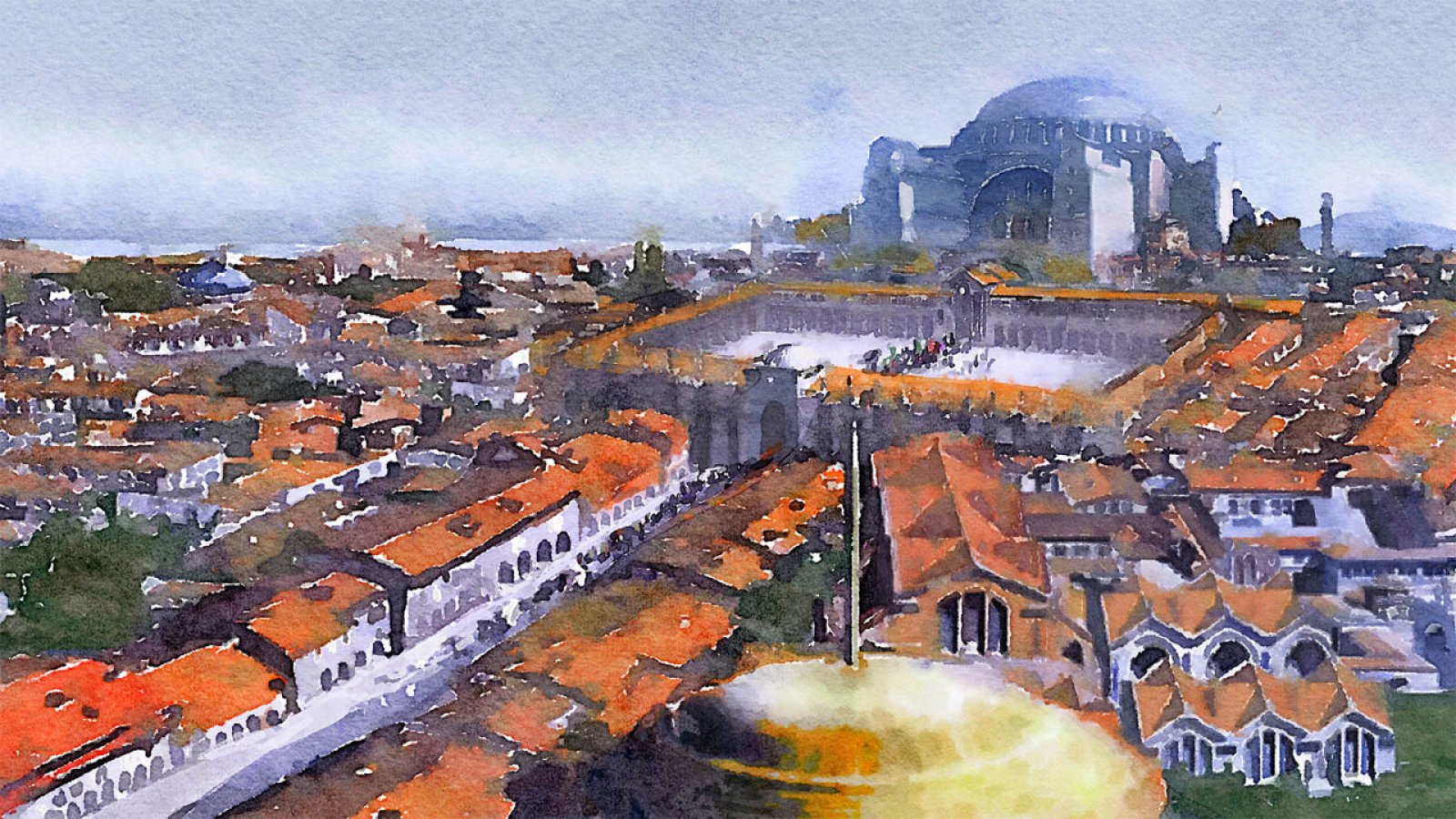Edited by: Tiffany Lillie
Lessons from the Past
At the Gates is a 4X strategy game developed and published by Conifer Games. Jon Shafer—the founder of Conifer Games—was the lead designer for Civilization V back when he worked for Firaxis. Since then, he has broken off to Kickstart this particular game. While At the Gates tries to differentiate itself from others within the 4X genre, its new mechanics fail to truly innovate and those it does repurpose are executed with less polish than those it would imitate.
Pax Romana
At the Gates plays very similarly to other 4X strategy games. You control one of the many Germanic tribes around at the time of the fall of the Roman empire, and it is your job to either replace or sack Rome. To do this, you will have to explore, expand, exploit, and exterminate to varying degrees. 4X strategy usually comes in two flavors, regardless of which win condition you’re attempting in any given playthrough: building tall, or building wide. “Building tall” means you have a handful of well-developed, powerhouse cities capable of pushing you to the end. “Building wide” is the opposite, where you cover as much territory as possible with as many cities as possible. At the Gates circumvents this by only affording you one city. Rather than this being a traditional 4X city where you can build improvements and units, it only really serves as a means of controlling resources and training the various clans that join you. Rather than being stuck in one place, you can pack up your city in the early game and rove around, allowing you to access multiple different resource nodes at a time.

There are benefits to settling down and declaring yourself a kingdom, however. Your city’s influence radius increases and you draw clans to your tribe faster. Clans are your lifeblood, as each clan is effectively one worker unit in your average 4X game. The bigger the clan, which naturally grows over time, and the better trained, the better they are at their selected job. There are six different disciplines that you can train a clan in, each with their own utility. Honor governs your standard, Viking-esque mead halls and warriors, but also tax collection. Agriculture and Livestock are your main sources of food and resources. Crafting and Metalworking govern resource collection of things like wood and stone and the refinement thereof. Discovery is your catch-all for science. There is overlap in each of these, with some jobs in a discipline increasing the effectiveness of some other job in a disparate discipline. Each clan has traits that gear them towards one discipline or another — or even one job within a given discipline. Some of them even arrive already knowing a job, saving you time in training them. Some of these traits also increase the likelihood of your clans feuding with each other, lowering their morale. Clans also occasionally get desires that impact their morale when not met but give a boost to it when they are.
Caligula’s Horse Consul
There's a lack of polish present in At the Gates. Many of the systems seem half-baked and don’t make much sense from a practical perspective, but there are also a variety of bugs and issues present at launch. The most glaring is perhaps the issue where the game reliably crashes after four to five hours of play time. Thankfully, it saves at the beginning of every turn so progress loss is unlikely, but it’s still worth mentioning.

At the Gates also features an extensive tooltip feature, allowing you to hover over most any keyword and get more detail on that particular concept. These tooltips also can branch into other tooltips ad infinitum. Unfortunately, you’ll eventually come across one that’s broken, especially in the tutorial. The tutorial itself is an issue, at that. You’re given a single tutorial pop-up at the beginning of your first game, and when you’ve run through that set of panels, you’re given a multiple-choice dialog for the next tutorial you’d like to read. This continues for a while. By the time I had read through all the tutorials available, I had spent an hour just reading text and was about twenty panels deep. While you can still interact with the game with tutorial pop-ups open, I can firmly attest that, even as lost as I was after reading all those text boxes, I would have been even worse off had I not done so.
Mechanically, there are a few headscratchers. In order to move about the map in the early game, your basic units degrade resources as they exploit them. Later game units can build structures that degrade resources slower but still wind up using it up. That is, of course, unless you build your structure out of stone instead of wood. Somehow, the magic of stone makes resources endless. This also circumvents the restriction on the area of control that the single city imposes. Each building, regardless of wood or stone, radiates its own zone of influence that you can then capture other resources with. One unit in particular, the Watchman, is wholly dedicated to this idea. The Watchman can build a watchtower that radiates influence as well, and you don’t even need to build the watchtower within an already-established zone of influence. Considering that the Watchman can be your third technology, it makes me wonder why you would even bother with the single-city scheme at all.
Rome was Beaten in an Afternoon
One interesting thing the tutorial takes time out to mention is that map generation is very “roguelike,” meaning it's procedurally-generated for each playthrough. While this is nothing new in the 4X genre, At the Gates specifically mentions that the first few playthroughs try to avoid extremes in map generation. It makes me wonder if other things are toned down for the sake of not frustrating the player on their first few outings. I mention this because At the Gates is almost criminally easy. I played through twice, each playthrough taking from four to six hours. Never once did I feel on the edge of defeat. The AI allowed me to sit at home, farming as many resources as I wanted, unimpeded with nary a fight over resources nor a barbarian come to destroy me. During my second playthrough, I was tempted to ignore combat entirely and just focus on resource collection for an economic victory. I opted instead to just rush to the tier-two warrior and use him to clear out any bandits I came across.

I’m skeptical as to whether or not this laid-back play style is intentional, as the tutorial also mentions that you aren’t in contention with the other tribes to take down Rome, so you can take your time; the other tribes are only interested in primacy amongst each other. However, unimpeded, primacy is rather easy to come by. There are two win conditions: economic and military. Military requires you to successfully sack Rome, while Economic requires you to train five of your clans as Roman legions and then send them off to declare your tribe as the Magister Militum.
The thing is, Roman legions are the strongest military units in the game, so if you’re going to sack Rome, you’ll want those units on your side. However, training them requires a handful of late-game resources and twenty-five turns. If you’re going to be training them anyway, why not take the extra twenty-five turns to just passively win? You’ve still won and get to keep whatever you’ve unlocked by conquering the other tribes if you chose to do so. Further, the Military victory requires you to find Rome in the first place. Every turn is about half a month in At the Gates, with maybe ten of those turns taking place during the winter months. Winter affects the tiles on the map; certain resources can’t be gathered during the winter and the “supply” stat is set to zero. A tile needs one supply for each unit on it, or those units start losing health each turn. During winter, the only tiles with supply scores are those within the bounds of your territory. This stymies exploration, as you’ll go so far out of your way to scour the map only to have to turn back come winter. By the time your base is stationary, it’s better just to stay at home anyway.
Frescoes and Greek Modes
While its contemporaries are predominantly 3D, At the Gates opts for a 2D, sprite-based art style. While nothing really stands out about it, it does effectively communicate which units are where and what they’re doing. The sound design, however, is lacking. There are very few sound samples and they're repeated continually — particularly the movement sound. While there is a specific sound for when a ship moves, it frequently glitches and makes the standard unit walking sound. The other sounds, such as when you recruit a new clan, sound like the dev team unenthusiastically recorded them in their office. There is also no music to speak of. The options menu lists a slider for “menu theme volume,” but no music actually plays while you’re in the main menu. While you’re in the game itself, everything is sparse ambience, and by that I mean a handful of nature sounds played on a loop while you order your units around. This leaves the soundscape very dry and uninteresting, ruining what little immersion I might have gleaned.
The Verdict: Flawed
At the Gates is an interesting proof of concept, but isn't fully fleshed out. There is little challenge to be had in the initial playthroughs, and asking the player to slog through rote gameplay for upwards of ten hours before it gets engaging is too much to ask. If you’re looking for a relaxing take on the 4X strategy genre that you can just shut your mind off and play, At the Gates provides an interesting take on those gameplay elements without asking much of you.


